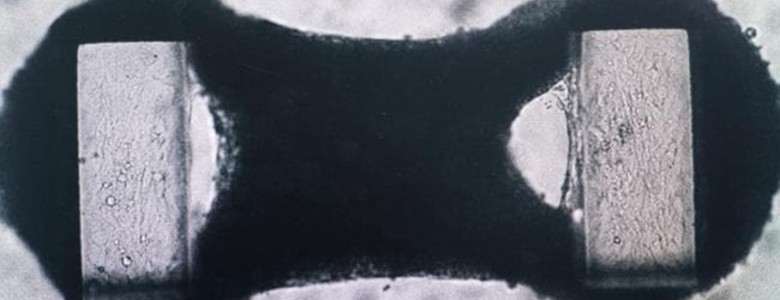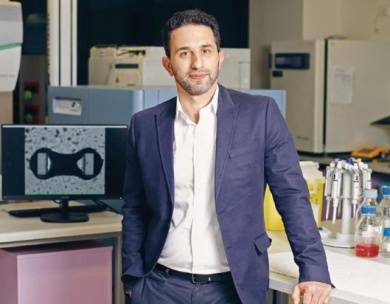Harnessing the capacity of a newborn’s heart

This article was first published in The Australian, written by Natasha Robinson.
The Circle of Life: Harnessing the capacity of a newborn’s heart to repair itself holds the key to new treatments for congenital cardiac disease
Professor Enzo Porrello will never forget the moment the miniature heart tissues he had created from stem cells came to life and began beating. Porrello was deep in a University of Queensland laboratory with his collaborator, tissue engineer Professor James Hudson, and the pair were instantly aware that their tiny innovation could one day transform the lives of those with congenital heart disease, or potentially anyone whose heart tissue had died following a heart attack.
 “Other scientists around the world had grown heart muscle cells from stem cells, but what nobody had done was to grow those cells as these sort of miniature complex three-dimensional tissues, and they weren’t able to grow those tissues in a format that was amenable to drug development,” says Porrello, who now heads the Heart Regeneration Laboratory at the Murdoch Children’s Research Institute.
“Other scientists around the world had grown heart muscle cells from stem cells, but what nobody had done was to grow those cells as these sort of miniature complex three-dimensional tissues, and they weren’t able to grow those tissues in a format that was amenable to drug development,” says Porrello, who now heads the Heart Regeneration Laboratory at the Murdoch Children’s Research Institute.
“And that’s really the technological breakthrough that we were able to make.”
The method Porrello and Hudson used to create the tiny structures seems miraculous: special molecules are added to stem cells that trigger them to morph into heart muscle tissue, which is grown in a plastic culture dish made up of 96 tiny wells. Within each well, the heart muscle cells condense around tiny elastic micropillars to form three-dimensional heart tissue.
“The geometry of the well is designed in such a way that the heart tissues spontaneously form when the heart muscle cells are inserted into the well,” Porrello says. “And those cells then condense around the tiny elastic micropillars within each well of the device and what you end up with is these tiny mini beating heart muscle tissues that are contracting around the elastic cantilevers, and each time the heart muscle contracts, those poles within the well deflect.
“And that then allows us to measure how much force those tissues are generating … to look at how fast they’re beating, whether or not they display any irregularities in their heartbeat in response to drugs or genetic manipulations of the stem cells. And so it serves as a pretty powerful platform for looking at drug responses, but also modelling genetic forms of heart disease.”
Following the breakthrough of creating the beating three-dimensional heart tissues, Porrello then co-founded a biotechnology company called Dynomics, which is using the technology to drive drug development programs for heart failure.
“We’re actually now scaling up these tissues and growing very, very large bioengineered heart tissue patches that can be implanted onto the heart”
Porrello’s desire to devote his life to heart regeneration has deeply personal roots. He had two cousins who were born with holes in their hearts, and one of the boys, Frankie, died at the age of nine. “It had a long-lasting impact on our family,” Porrello says. “I guess it served as an inspiration for my own research career and focus on researching childhood heart disease.”
Porrello established himself as a pioneer in the fledgling field of heart regeneration early in his career after researching abnormal enlargement of the heart and completing a PhD at the University of Melbourne and the Baker Institute. He then took up an academic post in Dallas, Texas, at one of the world’s leading labs researching heart development. There, his work studying the genetic maturation of mice hearts established that the mammalian heart retains the capacity for regeneration during the early neonatal period. Previously, this was believed impossible.
“This sort of changed our thinking of what was possible in terms of stimulating the human heart to regenerate itself following damage, such as a heart attack,” Porrello says. “And I guess this also fuelled my own interest in my subsequent career in the area of regenerative medicine.”
Later, Porrello heard of cases of human newborns recovering from massive heart attacks, and he became interested in exploring whether human newborn hearts may also retain their capacity for regeneration.
After his return to Australia and his breakthroughs at the University of Queensland, Porrello moved to Melbourne, where at the MCRI his research discoveries are being applied in a clinical context, bringing him closer to his dream of regenerating human hearts.
“The ultimate goal of my research is that one day we may be able to harness the newborn heart’s ability to repair itself”
Melbourne has established itself as one of the world’s leading centres in stem cell research, helped by a $454 million bequest from Denmark’s Novo Nordisk Foundation to the MCRI and its partners, the University of Copenhagen and Leiden University Medical Center in The Netherlands – one of the biggest ever donations given to scientific research in Australia.
MCRI’s Heart Regeneration Laboratory is focused on children with congenital heart disease. There are at least 2400 babies born with this disease in Australia every year, and it’s the leading cause of death in infants.
There are two arms to the MCRI cardiac regeneration research. In the first, which concentrates on disease modelling, Porrello’s team uses blood and tissue samples from sick children from the Royal Children’s Hospital in Melbourne to create to create lab-grown models of heart muscle to study disease.
“What this allows us to do is it allows us to model the genetic basis of disease in any individual,” Porrello says of the project. “We’re using this technology to model childhood heart disease, trying to understand its causes, and then using those genetic models of heart disease to test and develop therapeutic approaches to treat those conditions.”
“And the second arm of our research is the regenerative approach, where rather than developing or using these miniature tissues, we’re actually now scaling up these tissues and growing very, very large bioengineered heart tissue patches that can be implanted onto the heart, and can function as a sort of biological assist device to support heart function.”
Porrello’s team is currently evaluating the safety and efficacy of the heart tissue patches in preclinical animal studies, with funding from the Medical Research Future Fund and the Novo Nordisk foundation accelerating the process. They hope that human trials will begin within the next five years.
“If it works, it would be transformative,” Porrello says. “The only option for a child who develops heart failure and who’s not responding to standard frontline drug therapies currently is that they’re put on a heart-transplant waiting list, and they then are on mechanical support as a bridge to heart transplantation. Heart transplantation is limited by organ donor availability, and it’s also limited by the need for lifelong immunosuppression in those patients. And so if we’re able to develop these bioengineered heart tissues from stem cells, this could potentially prevent or delay the need for heart transplantation in these very unwell individuals with end-stage heart failure.”
At just 39, Porrello still has plenty of time to achieve his grand heart-regeneration vision.
“The ultimate goal of my research is that one day we may be able to harness the newborn heart’s ability to repair itself following injury, and that we may be able to develop drugs that can harness that dormant regenerative capacity and awaken the ability of the heart to repair itself following damage,” he says.
“I would say that based on recent studies in the field in the past 10 years since we first made our discovery in mice, we are certainly getting closer. There is sort of proof of concept that this is possible now, at least in mice, and the question is whether or not we can now make that a therapeutic reality in humans.”



